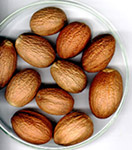
Pongamia Pinnata
BioFuels
Neem
Mahua
Castor
Undi
Kokam
Fish Oil
Fatty Oils
Expellers
BioGas
Organic Fertilizer
Jatropha
BioDiesel
Consultancy
Algae
Herbal Product
Climate Adaptation
Contact Me
My Resume
 |
Satish Lele lelejatropha@gmail.com |

Kokam (Garcinia indica)
Tree: A slender evergreen tree with drooping branches. Leaves are ovate or oblong, lanceolate, 5.5 to 8 cm long and 2.5 to 3 cm broad, dark green in the upper portion and pale in lower portion.
Flowers: In India, tree flowers in the month of November to February. The flowers are fleshy, dark pink, solitary or in spreading cluster.
Fruits: An average tree yields 60 to 80 kgs. of fruits, yielding seeds. In India, fruits ripen in April and May. The lemon sized dark purple ripe fruits contain five to eight large seeds. The fruit has an agreeable flavour and a sweetish acid taste. The fruit contains 10 per cent malic acid and a small proportion of tartaric and hydroxy citric acid. Fruit also contains anthocyanin colouring matters, cyanidin-3–glucoside and cyanidin-3-sambubioside.

Seeds: The seeds account for 20 to 23 per cent of the fruit weight. The kernels account for 61 per cent by weight of the seed and oil content of the kernel is about 44%.
Kokam is well spread in the evergreen tropical rain forests of Western Ghats from Konkan to Mysore. Heavy concentration is found in the coastal Ratnagiri district of Maharashtra. Scattered plantations have also come up in Belgaum, North Karnataka and Kerala. Kokam exists in Khasi and Jantia hills of North Eastern Hill region, West Bengal and Assam, up to the height of 6,000 ft. on slopes down to coastal areas. Kokam is quite predominant in East Indies.
Kokam's propagation is generally through seeds and silvi-culture. The nursery practices have not been systematically worked out. However, plantations are being done in Konkan and Goa by following usual practices of seeds sown in the poly bags and transplanting of seedlings in the pits.
The fat is called Kokam butter and Kokam butter is light gray to yellowish in colour. Solid fat is sold in form of oblong balls. Kokam butter is white, hard and brittle. It is a valuable edible fat known in commerce as Kokam Butter. Kokam butter is extracted mostly on a cottage industry basis by crushing the kernels, boiling the pulp in water and skimming off the fat from the top or by churning the crushed pulp with water. The alkali treatment and bleaching process changes the fat equivalent to Vanaspati Ghee.
Seeds are traditionally decorticated by wooden mallets and fat recovered by water rendering. The yield in this case will be 25%. Seed can also be decorticated in decorticator and kernels are pressed in expeller, yielding 34-44% of oil. Hot filtration, solvent extraction will help to recover residual fat from cake.
The pulp of the fruit is a very popular culinary ingredient in Maharashtra and in particular in Konkan area. The fruits are beaten with sticks to separate the rind from seeds. The rind is repeatedly sun dried after soaking in the pulp juice. The dried purplish rinds, known as Kokam, are used for imparting flavour and taste to curries, much in the same way as tamarind fruit pulp is used in South India.
The fruit is anthelmintic and cardiotonic and useful in piles, dysentery,
tumours, pains and heart complaints.
Kokam butter as sold in market, consists of eff shaped lumps or cakes, having a greasy feel and a bland oily taste. Kokam butter is used mainly as edible fat. Kokam butter is also used as an adulterant in Ghee. Kokam butter is considered nutritive, demulcent, astringent, suppositories and other pharmaceutical preparations.
The cake left after extraction of oil is used as organic manure. Cake can also be used as cattle feed since cake contains 15.5% proteins, 57.27% carbohydrates in extracted cake, having no toxic principles, but cake has sour taste which can be eliminated by washing the cake with water.
For seeds contact:


